
The orange-headed thrush is a bird in the thrush family.
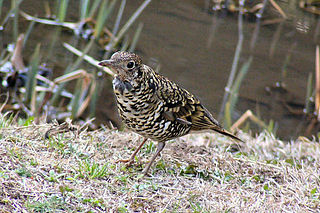
The Asian thrushes are medium-sized mostly insectivorous or omnivorous birds in the genus Zoothera of the thrush family, Turdidae.

The pied thrush is a member of the thrush family found in India and Sri Lanka. The males are conspicuously patterned in black and white while the females are olive brown and speckled. They breed in the central Himalayan forests and winter in the hill forests of southern India and Sri Lanka. Like many other thrushes, they forage on leaf litter below forest undergrowth and fly into trees when disturbed and sit still making them difficult to locate.

The plain prinia, also known as the plain wren-warbler or white-browed wren-warbler, is a small cisticolid warbler found in southeast Asia. It is a resident breeder from Pakistan and India to south China and southeast Asia. It was formerly included in the tawny-flanked prinia, resident in Africa south of the Sahara. The two are now usually considered to be separate species.

The jungle prinia is a small passerine bird, a warbler in the family Cisticolidae.

The crested goshawk is a bird of prey in the family Accipitridae that is widely distributed in tropical Asia. It was formerly placed in the genus Accipiter.
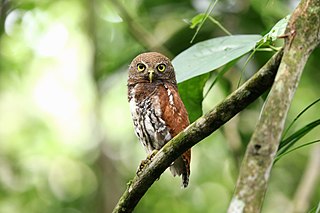
The chestnut-backed owlet, is an owl which is endemic to Sri Lanka. This species is a part of the larger grouping of owls known as typical owls, Strigidae, which contains most of the smaller owl species. This species was formerly considered to be a subspecies of the jungle owlet.

The collared scops owl is an owl which is a resident breeder in south Asia from northern Pakistan, northern India, Nepal, Bangladesh, the Himalayas east to southern China, and Taiwan. It is partially migratory, with some birds wintering in India, Sri Lanka and Malaysia. This species was formerly considered to be included within what is now separated as the Indian scops owl.

The brown wood owl is found in India, Bangladesh, Sri Lanka, Indonesia, Taiwan, and south China. The brown wood owl is a resident breeder in south Asia. This species is a part of the family of owls known as typical owls (Strigidae), which contains most species of owl. It belongs to the earless owl genus Strix.

The Indian scops owl is a species of owl native to South Asia.
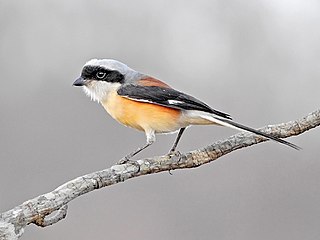
The bay-backed shrike is a member of the bird family Laniidae, the shrikes, resident in South Asia.

The black-faced solitaire is a bird in the thrush family endemic to highlands in Costa Rica and western Panama.

The rufous-tailed plantcutter, sometimes called the Chilean plantcutter, is a passerine bird of southern South America, now placed in the cotinga family. It is a medium-sized bird about 19 centimetres (7.5 in) long with a long black tail with a red base. Males have greyish-brown upper parts, a chestnut crown and breast, and dark facial markings. Females are similar but lack the chestnut crown and have streaked, buff underparts. There is a wing bar which is white in the male and buff in the female. This is a fairly common species with a wide range, and the International Union for Conservation of Nature has rated its conservation status as being of "least concern".

The speckled wood pigeon, also known as Hodgson's pigeon or Jungle pigeon, is a medium-sized pigeon of the bird family Columbidae and genus Columba. It is a monotypic species. It measures 38-40 cm in length, with males featuring a pale gray head and females having a grayish-brown head. Males have a distinctive pinkish-silver breast speckled with black spots and a maroon belly, while females exhibit less vibrant coloration. Both sexes have blackish-brown tails and primaries, iris color differs slightly. The species is distributed across the Himalayas extending from Kashmir to western and central China, as well as parts of India, Myanmar, Laos, Thailand, Pakistan, Nepal, Bhutan, and Afghanistan. Inhabiting evergreen and semi-evergreen hill forests at elevations of 1,800-4,000 meters, descend in winter based on food availability. Diet consists mainly of acrons, berries, and fruits, typically foraging in small flocks. Breeding occurs from May to August, with nests situated 3-8 meters above ground.
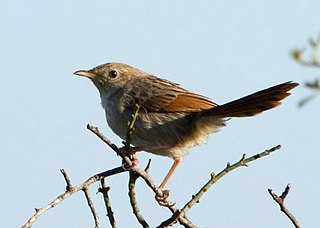
The grey-backed cisticola or red-headed cisticola is a small passerine bird. This cisticola is a resident breeder in southernmost Angola, Namibia and western South Africa.

The black-backed forktail, occasionally referred to as the black-throated forktail, is a forktail species in the family Muscicapidae. The species was described in 1836, from a specimen collected in Nepal. It is a medium-sized forktail, weighing between 25 and 29 grams, with a length of 20.5 to 23 centimetres. The species has a broad white stripe across its forehead. The crown, face, and mantle are black, while the bird's underparts are white, sharply divided from the black above. The wings are largely black with a broad white stripe across the greater coverts. The tail of the species, similar to that of other forktails, is long, graduated, and deeply forked. The tail is black with a white tip and three white bands created by shorter tail feathers. The beak of the bird is black, while the feet and legs are light pink, and the iris is brown. The species is monomorphic.

The rufous-capped antshrike is a species of bird in subfamily Thamnophilinae of family Thamnophilidae, the "typical antbirds". It is found in Argentina, Bolivia, Brazil, Paraguay, Peru, and Uruguay.

The ashy thrush, also known as the ashy ground-thrush, is a species of bird in the family Turdidae. It is endemic to the Philippines in Luzon and Mindoro. Its natural habitats are tropical moist lowland forests and or tropical moist montane forests. It is threatened by habitat loss, and the illegal wildlife trade.
The swamp grass babbler or swamp prinia is a small bird of the Indian subcontinent. Some authorities consider it a subspecies of the rufous-vented grass babbler.
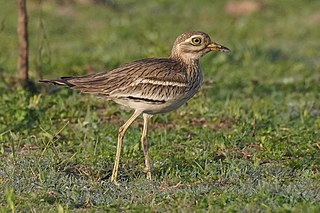
The Indian stone-curlew or Indian thick-knee is a species of bird in the family Burhinidae. It was formerly included as a subspecies of the Eurasian stone-curlew. This species is found in the plains of South and South-eastern Asia. They have large eyes and are brown with streaks and pale marks making it hard to spot against the background of soils and rocks. Mostly active in the dark, they produce calls similar to the true curlews, giving them their names.























